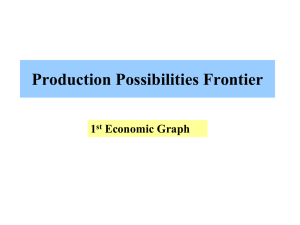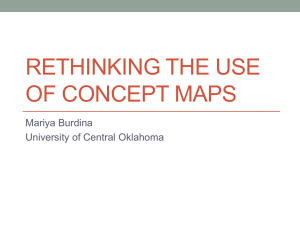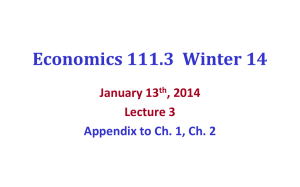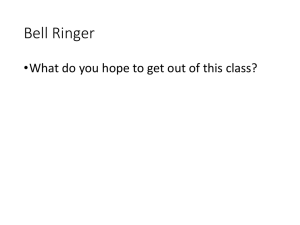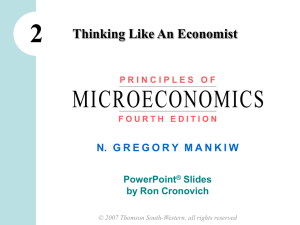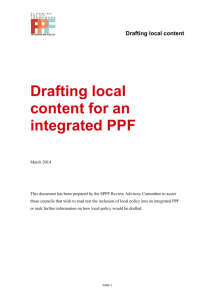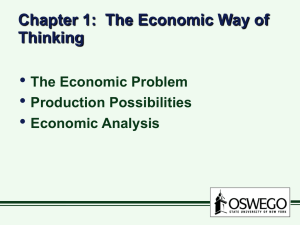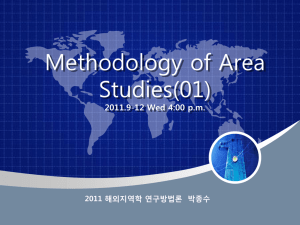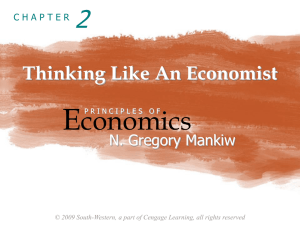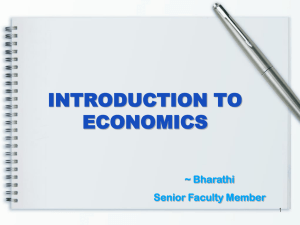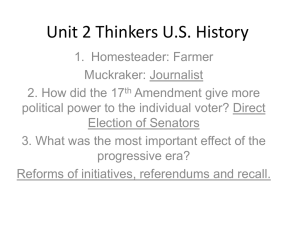CH2-1 PPF
advertisement
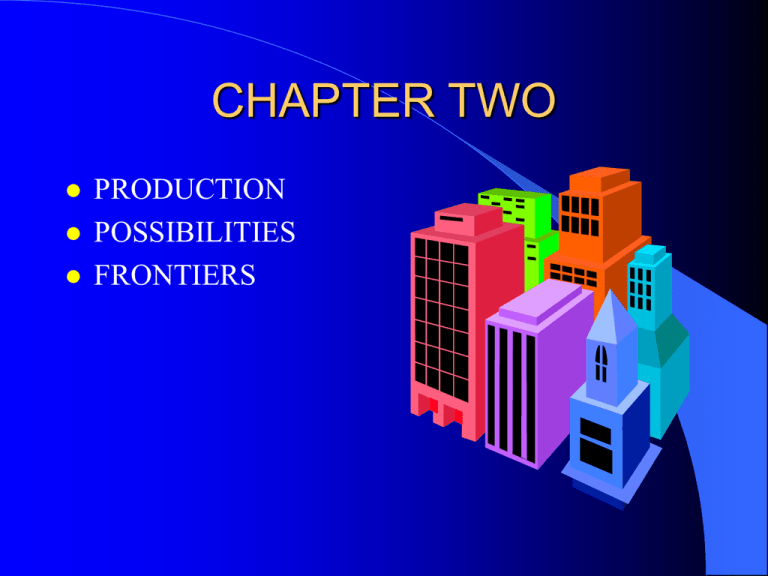
CHAPTER TWO PRODUCTION POSSIBILITIES FRONTIERS CHOICES Choices involve the balancing of having more of one thing against having less of another Arriving at the best balance possible within your limits is called OPTIMIZING Exhibit 1 Production by Elizabeth and Brian COMPARATIVE ADVANTAGE a basis for trade exists when each of two countries, both capable of producing the same two goods, specialize in the good that is relatively cheaper to produce MAIN IDEA COMPARATIVE ADVANTAGE is a situation where a country can produce a good at a lower opportunity cost than another country. Opportunity Cost and Comparative Advantage Elizabeth: the opportunity cost of producing one loaf of bread is one apple Brian: the opportunity cost of producing one loaf of bread is three apples Elizabeth can produce bread at a lower opportunity cost than Brian can SPECIALIZATION Elizabeth produces only bread and produces 20 loaves of bread Brian produces only apples and produces 30 apples Decide to trade 8 loaves of bread for 12 apples Exhibit 2 Consumption for Elizabeth and Brian with and without Specialization and Trade MAIN FACTS ABOUT THE PPF Production Possibilities Frontier (or PPF) – A graph of the combinations of various goods that the economy can possibly produce with its resources and technology ASSUMPTIONS OF THE PPF Fixed amount of resources Constant level of technology Full employment of resources Efficient Production MAIN FACTS ABOUT THE PPF Points on the PPF – Each point on the PPF shows one combination of goods – All points under the PPF are also possible – Points above the PPF are impossible MAIN FACTS ABOUT THE PPF DOWNWARD SLOPE OF THE PPF implies: scarcity opportunity cost choice MAIN FACTS ABOUT THE PPF Technical Efficiency – Points on the PPF are technically efficient combinations of output Means that it is impossible to produce more of one good without producing less of another The economy does not waste resources MAIN FACTS ABOUT THE PPF Technical Inefficiency – Points under the PPF indicate technically inefficient production Means that the economy could alter its use of resources so that it produces more output of some good without producing less of anything else EXPLANATION AND EXAMPLES Steve's PPF EXPLANATION AND EXAMPLES When is the PPF a Straight Line? – The PPF is a straight line if the opportunity cost of producing each good is independent of its level of production – Resources are equally well suited for producing both goods PPF (Example) Compact Disc (CD): $10 each Cassette Tape (CT): $5 each - Opportunity cost of one CD? - Opportunity cost of one CT? - Your resources: $100 - Draw PPF of CD and CT EXPLANATION AND EXAMPLES When is the PPF Curved? – The PPF is curved when the opportunity cost of producing each good in the graph depends on the amount produced EXPLANATION AND EXAMPLES LAW OF INCREASING COSTS Because resources are not completely adaptable to alternative uses, the opportunity cost increases as society wants an increasing amount of a particular product SHIFTS IN THE PPF When does the PPF Shift? – The PPF shifts whenever the economy's resources change, or when technology changes SHIFTS IN THE PPF SHIFTS IN THE PPF Economic Growth – Refers to an increase in the economy's output of goods and services per person A growing economy's PPF expands faster than its population grows – Occurs when the economy either gains new resources or discovers better technologies SHIFTS IN THE PPF DEPRECIATION - THE PORTION OF THE CAPITAL STOCK THAT IS WORN OUT IN THE PRODUCTION OF THIS YEAR’S OUTPUT If capital production is greater than depreciation, the PPF grows If capital production is less than depreciation, the PPF shrinks CHAPTER 2 continued ECONOMIC SYSTEMS CAPITALISM AND SOCIALISM These are the two basic economic structures society uses to answer the basic economic questions. ECONOMIC POLICY GOALS Full Employment Price Stability Economic Growth Increase the Well-Being of the Members of Society TYPES OF ECONOMIC SYSTEMS Decentralized Pure Capitalism Mixed economies Centralized Socialism TYPES OF ECONOMIC SYSTEMS DECENTRALIZED - a system in which individuals own the factors of production and decide individually how to use them. CENTRALIZED - a system in which the government controls the factors of production and makes decisions on their use MIXED SYSTEM - the government and individuals are both involved. BASICS OF CAPITALISM The interaction of individual buyers and sellers pursuing their own self interests address the questions of what, how, and for whom. ELEMENTS OF CAPITALISM Private Property Market Allocation Competition Freedom of Enterprise Freedom of Choice Limited Government ARGUMENTS FOR PURE CAPITALISM EFFICIENCY - competition leads individual to seek the least expensive production techniques SELF INTEREST - private ownership will lead individuals to get the highest value from their resources. INDIVIDUAL FREEDOM GROWTH BASICS OF SOCIALISM Individuals only control their labor while capital and land are controlled by the government. Central planners address the questions of what, how and for whom to produce. ELEMENTS OF SOCIALISM Government ownership of resources Centralized allocation of resources Prices set by planners Emphasis on equitable distribution of income ARGUMENTS FOR SOCIALISM EXTERNALITIES - a command system can force price adjustments for compensate for external costs or benefits. PUBLIC GOODS - certain goods are better provided collectively (national defense). EQUITABLE DISTRIBUTION OF INCOME TWO VISIONS OF THE MARKET Capitalist thinkers believe markets, in general, are efficient and effective allocation mechanisms while socialist thinkers see several problems inherent in a market system. PRICES Capitalist thinkers believe that prices ration goods and services, convey information, and serve as incentives. Socialist thinkers view prices as being set by greedy businesses with vast economic power. COMPETITION Capitalist thinkers believe that is a strength that is omnipresent in the market. Socialist thinkers view the market as being dominated by big businesses which dictate prices and manipulate consumers. PRIVATE PROPERTY Capitalist thinkers believe that private property encourages individuals to make the most efficient use of the resources they own. Socialist thinkers believe that those with property have greater political power and use their power to take advantage of those without property. EXCHANGE Capitalist thinkers see exchange as a mutually beneficial action between concenting parties. Socialist thinkers would often see exchange as benefitting one person at the expense of the other. ROLE OF GOVERNMENT Capitalist thinkers tend to be wary of the government’s ability to protect the interests of society as a whole. Socialist thinkers see government decisions as promoting the best interest of society as a whole. ANY QUESTIONS?
